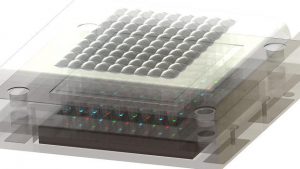
News
Plessey micro-LEDs selected for AR glasses

“This development with Vuzix, a leading actor in the exploration of next-generation augmented reality, is a significant endorsement of Plessey’s GaN-on-silicon microLED approach,’ said Plessey CEO Dr Keith Strickland.
Quanta-Brite is a light source for illuminating DMD (digital micro-mirror device) or LCoS (liquid crystal-on-silicon) display engines, based on monolithic arrays of micro-LEDs, which Plessey claims will enable an optical system up to 50% smaller, lighter and simpler than incumbent solutions, as well as improve power-efficiency.
“Plessey’s Quanta-Brite technology can be a major enabler of the future of augmented reality,” said Vuzix CEO Paul Travers. “As well as delivering high-efficiency, low-power and small-size illumination capabilities, the very high level of luminescence of the light source can also enable the development of end products with a sleeker form factor, which is a key attribute of our wave-guide based smart glasses and critical to mass market adoption.”
The micro-LED arrays are built using Plessey’s GaN-on-silicon technology, combined with its integrated circuit building knowledge that allows inter-LED conductors to be formed on-die. The firm has also developed a way to deposit red and green phosphors on two thirds of the inherently blue-emitting micron-scale LEDs to produce hundreds or thousand of RGB pixels.
“The Quanta-Brite illuminator comprises an array of switchable RGB pixels with integrated first level optical elements for optimised light extraction, simplified additional optical elements and uniform illumination,” Plessey marketing director Myles Blake told Electronics Weekly. “All pixels of a single colour are addressed as one and phased with the DMD or LCoS requirements. The overall package size for monolithic RGB array, near-die collimation and lenslet is below is 5.5 x 5 x 2mm.
Vuzix has already developed smart glasses culminating in the Vuzix Blade, which uses proprietary waveguide optics formed from nano-structures on glass. The next generation, according to Plessey, will use Plessey micro-LED arrays.
This announcement does not cover RGB micro-LED displays, intended to entirely replace DMDs and LCoSs, which some contend will be the ultimate image source for AR glasses.
“Quanta-Ray is the Plessey product family name for the RGB array that provides individually addressable sub-pixels of RGB, therefore providing fully addressable RGB pixels within the array,” said Blake.